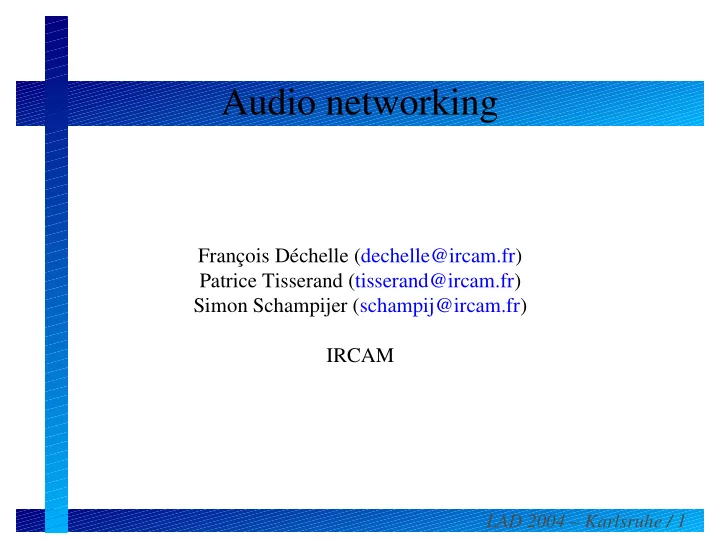

Audio networking François Déchelle (dechelle@ircam.fr) Patrice Tisserand (tisserand@ircam.fr) Simon Schampijer (schampij@ircam.fr) IRCAM LAD 2004 – Karlsruhe / 1
Distributed virtual concert project and issues network protocols and libraries nJam Experimentations in grid computing what it is middlewares for grids tests and benchmarks LAD 2004 – Karlsruhe / 2
Distributed virtual concert Goal: to distribute a concert (musicians, sound engineers and public) on the Internet Performance is geographically distributed Real time audio streaming over Internet Developed technologies can be applied to other domains (virtual or augmented reality distributed applications) A joint project between Ircam and CNAM LAD 2004 – Karlsruhe / 3
Similar projects SoundWIRE (CCRMA): using networks with high QoS for musical collaborations GRAME: distributed rehearsal, network protocol for events streaming, clock skew compensation Many others, using ISDN or MIDI over internet or OGG or ... LAD 2004 – Karlsruhe / 4
Issues Network adds a latency that varies a lot Latency is difficult to manage for a musician Real time and transfer reliability are difficult to obtain together n sources and m destinations means high traffic and requires native multicast Clock skew between sources and destinations LAD 2004 – Karlsruhe / 5
Network protocols for audio RTP/RTCP real-time protocol for audio and video applications RTP uses UDP as underlying layer provides packets typing and timestamping RTCP provides control and reporting Other protocols of interest: SIP/SDP: Session Initiation/Description Protocol RTSP: Real Time Streaming Protocol LAD 2004 – Karlsruhe / 6
Libraries and applications Some libraries that implement RTP: liveMedia ( www.live.com/liveMedia ) ccRTP ( www.gnu.org/software/ccrtp/ccrtp.html ) Vovida ( www.vovida.org ) UCL Common ( www-mice.cs.ucl.ac.uk/multimedia/software ) Some applications that support RTP: VideoLan Mplayer LAD 2004 – Karlsruhe / 7
nJam An implementation of the distributed virtual concert inside jMax with the UCL library Multicast support Each participant sends local sound on a multicast address and receives all participants streams A distributed algorithm compensates network latency and resynchronizes locally all streams Musicians hear themselves with a fixed delay LAD 2004 – Karlsruhe / 8
nJam experimentation Experimentation of a distributed concert during Résonances 2003 at Ircam 4 musicians on 2 sites Soft multicast using a tunnel Musicians trained fast during rehearsal Public presentation failed: port scanning attack just before concert no QoS network giving priority to audio packets LAD 2004 – Karlsruhe / 9
Jack RTP client Goals: implement distributed virtual concert outside jMax provide a networking Jack client using standard protocols First development using LiveMedia library Multicast support Under development... LAD 2004 – Karlsruhe / 10
Distributed virtual concert: future Finish the reimplementation using Jack Add control to the Jack client (with which protocol?) Implement clock skew compensation (difficult issue: breaks the synchronization algorithm) Make large scale tests Consider xDSL (compression, no multicast) LAD 2004 – Karlsruhe / 11
Grid computing Virtualization of computing and data resources over high speed networks Unlike clusters, grids can be geographically distributed and heterogeneous Used mainly in high performance computing Based on open standards and protocols, the Open Grid Services Architecture (OGSA) LAD 2004 – Karlsruhe / 12
Grid computing for audio Audio is less demanding than particle physics, but grid computing can help to ... get more CPU than your single desktop ... process large sound databases ... use applications remotely ... explore large parameters spaces LAD 2004 – Karlsruhe / 13
Ircam grid testbed Small deployment for tests and benchmarks « cycle stealing » on standard workstations Linux only for now, Mac OS X soon 2 middlewares tested: Globus toolkit (http://www.globus.org/) XtremWeb (http://www.xtremweb.org/) Future deployment : ~ 60 machines LAD 2004 – Karlsruhe / 14
The Globus toolkit A free software toolkit for building grids The base of many grid deployments Features: grid security remote job submission and control high-performance secure data transfer system and service information Heavy, but efficient, standard and portable LAD 2004 – Karlsruhe / 15
XtremWeb A free software platform for global computing Architecture: servers dispatch jobs workers execute jobs dispatched by servers clients submit and control jobs Much lighter than Globus, portable, but less efficient than Globus Still under development LAD 2004 – Karlsruhe / 16
Globus vs. XtremWeb Example using Csound: On a 4 machines grid, speedup is about 2 Disappointing, but can be explained... LAD 2004 – Karlsruhe / 17
Issues Globus is too heavy for a large deployment on a grid of desktop machines XtremWeb is not enough stable and efficient Our testbed is too small Heterogeneity is difficult to manage But it offers interesting possibilities LAD 2004 – Karlsruhe / 18
Grid computing: future Distributed computation by exploding each computation into a set of jobs communicating via MPI: MPI speed can be an issue not all applications can be parallelized this way Merging of grid services and web services (Globus toolkit 4) Integration with streaming architecture LAD 2004 – Karlsruhe / 19
Recommend
More recommend